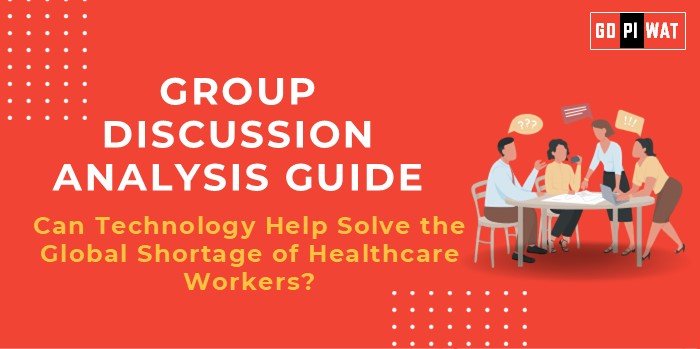📋 Group Discussion (GD) Analysis Guide: Can Technology Help Solve the Global Shortage of Healthcare Workers?
🌐 Introduction to the Topic
Opening Context: The global healthcare sector faces an alarming shortage of workers, with a projected gap of 10 million by 2030 according to the WHO. In this scenario, technology emerges as a potential game-changer, offering solutions to optimize healthcare delivery and alleviate workforce constraints.
Topic Background: Advances in telemedicine, AI, robotics, and mobile applications have demonstrated their potential to mitigate the burden on healthcare systems. Recent events like the COVID-19 pandemic accelerated the adoption of tech-driven healthcare, underscoring its relevance and challenges.
📊 Quick Facts and Key Statistics
– 📈 Telemedicine Growth: Global market valued at $87 billion in 2022, expected to grow at 22.1% CAGR by 2030 (Fortune Business Insights).
– 🩺 AI in Diagnostics: Reduces diagnostic errors by up to 20% (Harvard Medical School).
– 🤖 Robotic Surgeries: Over 7 million performed globally in 2023 (Intuitive Surgical).
🤝 Stakeholders and Their Roles
- 🏛️ Governments: Fund telemedicine programs, regulate AI use in diagnostics.
- 🏥 Healthcare Providers: Deploy technology for operational efficiency and patient care.
- 💻 Tech Companies: Innovate AI, robotics, and healthcare applications.
- 🧑💻 Citizens: Engage as proactive users of telehealth and wearable devices.
🏆 Achievements and Challenges
✨ Achievements
- ✅ Telemedicine Adoption: Increased accessibility in underserved regions (e.g., India’s eSanjeevani platform).
- 📈 AI Diagnostics: Improved accuracy and speed in detecting diseases like cancer.
- 🤖 Robotics in Surgery: Enabled minimally invasive procedures, reducing recovery times.
- 📱 Mobile Health Apps: Supported chronic disease management for millions.
⚠️ Challenges
- 🌐 Digital Divide: Limited access to technology in rural or underdeveloped regions.
- 📚 Training Gaps: Healthcare workers require training to effectively use new technologies.
- 🔐 Ethical Concerns: AI biases and data privacy issues.
🌍 Global Comparisons
- 🇪🇪 Success: Estonia integrates e-health records seamlessly.
- 🌍 Challenge: Limited AI adoption in low-income nations due to cost.
💡 Case Studies
- 🇷🇼 Rwanda: Drone-based medical supply delivery is a model of innovation.
💬 Structured Arguments for Discussion
Supporting Stance: “Technology enables healthcare systems to overcome workforce shortages through AI, telemedicine, and automation.”
Opposing Stance: “Reliance on technology is limited by digital divides and ethical concerns.”
Balanced Perspective: “While technology addresses workforce challenges, inclusivity and ethical frameworks are essential for success.”
📚 Effective Discussion Approaches
- 📊 Opening Approaches:
- 📈 Use statistics like the WHO workforce shortage projection.
- 🌟 Start with a case study, e.g., Rwanda’s drone delivery.
- 🤝 Counter-Argument Handling:
- ✅ Recognize gaps, like training issues.
- 💡 Offer solutions, e.g., tech literacy programs.
🔍 Strategic Analysis of Strengths and Weaknesses
– ⚠️ Weaknesses: Cost barriers, training challenges, and ethical dilemmas.
– 🌟 Opportunities: AI in medical education, 5G-powered telemedicine.
– ⚠️ Threats: Cybersecurity risks, misuse of sensitive health data.
📈 Connecting with B-School Applications
- 🌍 Real-World Applications:
- Explore projects in tech-driven healthcare or AI implementation in hospitals.
- ❓ Sample Interview Questions:
- 💬 “What role does AI play in bridging healthcare workforce gaps?”
- 💡 “How can governments ensure equitable access to telemedicine?”
- 📖 Insights for B-School Students:
- Innovate cost-effective tech solutions for low-resource settings.
- Leverage AI for efficiency in healthcare management.


